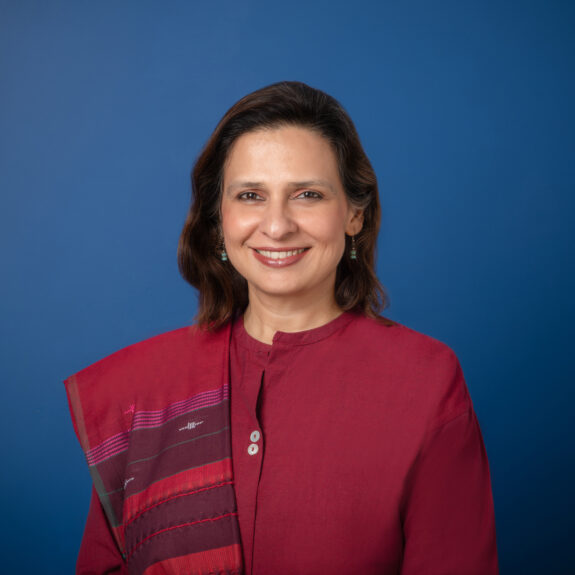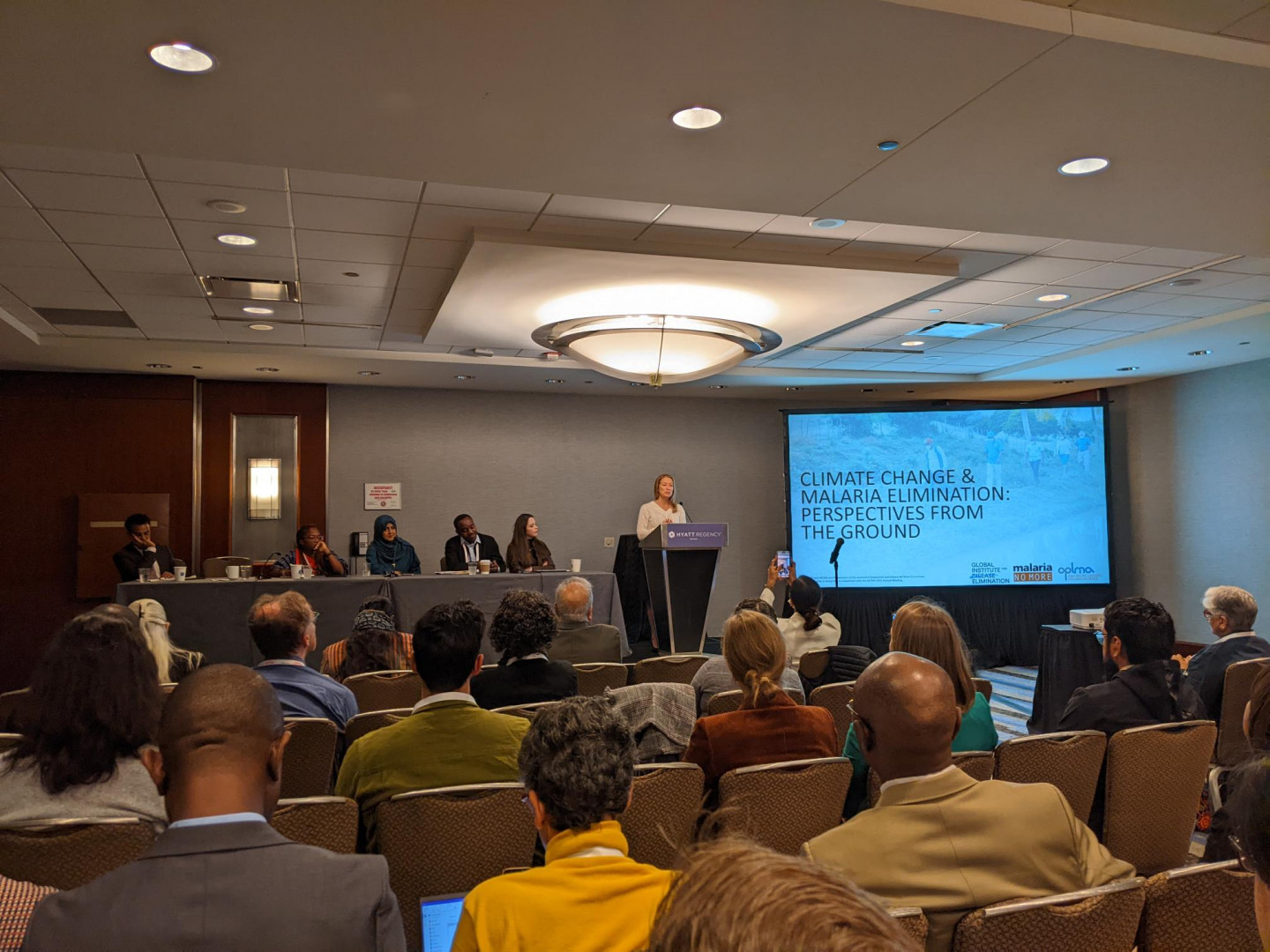In a discussion with Forecasting Healthy Futures, Dr. Tabinda Sarosh, CEO of Pathfinder, talks about how the climate crisis uniquely impacts the health of women and girls.

As CEO of Pathfinder, with over two decades of experience in the humanitarian and development sector, what makes Pathfinder’s mission so unique and why were you passionate about joining?
SAROSH: That is a good question! I am, by education, a clinician … a medical doctor. But long before I got my medical education, I was a part of the local women’s rights movement and grew up around a lot of women’s rights activists in South Asia.
And at that time, the women's movement in Pakistan was agitating against laws that limited a women's ability and agency to exercise their bodily autonomy. This included rape laws that required women to produce witnesses.
After my medical education, I decided to pursue public health, but combine it with contributing to women's bodily rights, autonomy, and agency. So, I joined a Pakistani feminist collective which was taking a very intersectional approach to women’s health, including working on climate and environment. We did a lot of work around age of marriage. To prevent child marriage, for example, we conducted extensive research and an advocacy campaign that resulted in a legislation change in the country, and standardizing the age of marriage to 18. Additionally, we were doing a lot of work around maternal and reproductive health. We must recognize that women and girls face a different kind of a stigma when they access services. And that is where practitioners like us can help form a bridge between women in communities and health systems.
This journey led me to Pathfinder, which supports women’s health, well-being, and growth, ensuring every woman can reach her full potential and drive catalytic impact in her community and country. I joined Pathfinder in 2016 as the country director for Pakistan, where I introduced integrated climate and health programs, given my background in cross-sectional programming and advocacy campaigns where climate was also at the forefront. Evidence had started coming in as far back as two decades ago that climate was having an impact on the health of women and girls, especially those associated with agricultural movements. That went on to build our organizational strategy for climate and health.
We focus on women-led, and community-led climate resilience by strengthening health systems so that they are responsive to the impacts of climate change, particularly on the health of women. COVID-19 gave us quite a few insights into what health systems can look like if they’re overwhelmed, and that’s what climate change can also do. But we also know that women, particularly pregnant women, have unique challenges when it comes to dealing with diseases and epidemics.
I’m very excited to be the CEO of Pathfinder right now. It can seem cliché to say this is the most challenging moment, but we cannot deny that this is indeed a historical moment where the need is the greatest. Women and girls are facing challenges like they’ve never had before. But there are also great opportunities for women’s leadership on climate and health. The idea is to solve for women’s agency and create pathways to leadership and sustainable solutions that work for them.
Pathfinder is unique because we take a very in-depth approach towards systems from top to bottom – and then bottom up. We look to understand where there are moments of optimization in health systems – and where are the gaps that can be filled, whether it’s building capacity, developing the health workforce (and let’s not forget that most of the frontline health workforce is women) or collecting data. So, we’re working at the higher policy level to activate implementation plans and then supporting governments to implement those plans. That’s why we’re unique – we bring all that expertise and then hone it in on women and girls and services specifically for them.
More and more data show that women’s needs don’t stand in silos. For example, when you’re in a community addressing family planning, you quickly realize that women are also dealing with food insecurity. And food insecurity is more often than not connected to climate change …or connected to poverty … or connected to the ability to access other resources. So, we can no longer take simply a vertical approach.
At Pathfinder, I’m excited and optimistic about the connections we’ve been making, as well as the innovations we’re introducing.
What are some of the biggest health challenges facing women and girls as a result of climate change? What are the solutions? And how do we scale those solutions?
SAROSH: One of the first challenges that comes to mind is around age of marriage – and looking at the various drivers that motivate parents to arrange early marriages for girls, such as food insecurity, drought or conflict. That combined with the compromised status of women and girls who live in societies entrenched in patriarchy. We know women are often the last to eat, the last to go to a health service, and many times their first interaction with a healthcare provider is when they are going for pregnancy- and delivery-related services.
So, we must look at how to increase those health engagements for women. In climate-affected areas, situations are often compounded with challenges, such as transportation issues, or competing priorities with food, education and childcare. And we know that the changes that come through climate change become real stressors for women. When that’s the case, they often resort to unhealthy, unsafe choices that only compound the entire problem.
For example, women health workers in climate-affected areas, many times must walk miles and miles to reach households and provide services to them. Women and girls are often responsible for fetching water for their families, sometimes walking miles and miles to a water source, keeping them from attending school, earning an income, and exposing them to gender-based violence. In climate-affected areas, we also see a deprioritization of education, because the economic stresses can often force a household to rely on the labor of their children.
A case study that I often cite is the fisher women in Kenya around Lake Victoria, because when the fishing catch diminished and many men had moved out of the region, it left the women behind to tend after the children. So, then the women started fishing. But for a fish to then reach the market, women often faced other challenges, such as coercion, transactional sex, and other forms of discrimination like not being offered the right price for the fish. So, these pre-existing challenges are exacerbated by climate change and multiply.
Why is it so important to use intersectional approaches to climate and health to address these specific challenges faced by women and girls – and what approaches is Pathfinder using?
SAROSH: As mentioned, vertical approaches often don’t work, because women don’t have regular access to systems or don’t even access healthcare systems unless they are pregnant. When we talk about intersectional approaches to maximize opportunities for women, we’re talking more in terms of multisectoral. For example, understanding the issues for women around sexual reproductive health, but also how their situations are being compounded by climate change. But it's also issues around privilege, race and caste in many societies – these sorts of issues are all interwoven.
One of the things we’ve been advocating and implementing is integrated delivery models, especially for primary healthcare. Once again, primary healthcare is that one opportunity to reach out to women and girls, so we work to integrate nutrition, vaccinations, counseling, and so on within primary healthcare services. That’s where Pathfinder, with the integrated service delivery model, has found the most success.
As a virtual keynote speaker for the recent Forecasting Healthy Futures Summit in Brazil, why is it important to highlight the intersection of climate and health?
SAROSH: Just the name Forecasting Healthy Futures, reflects how important it is for us to look at the future and understand where we can be. While we may think the future may not be as rosy as we would want it to be, we also recognize that we do have an opportunity to create solutions that are sustainable and scalable right now.
Pathfinder is also a name that gives me joy, because we are pathfinding into the future. So, this was a natural marriage for Pathfinder and Forecasting Healthy Futures to come together.
As we work toward the next COP, we know health continues to be at the forefront of climate-related talks. As we consider the future, health is going to become even more important. Stresses from funding disruptions coupled with climate impacts will continue to multiply. That’s why we have to focus on becoming even more innovative and meet people from different organizations or other parts of the world to share our learnings and solve health challenges posed by climate change, together. Groups like FHF, for example, will become only increasingly important, particularly for women’s and girls’ health and their overall well-being.
What gives you hope?
SAROSH: What gives me hope? Women and girls! They give me hope. Definitely. Technology also gives me hope. For example, women and girls are demonstrating tremendous leadership when it comes toward leveraging technology, innovating solutions and expressing themselves. Women are using technology to voice what’s wrong, what they need or what could be done better and creating solutions that are helping the planet. They come from different parts of the world, but they are coming together and sharing, learning and unlocking potential.
###


